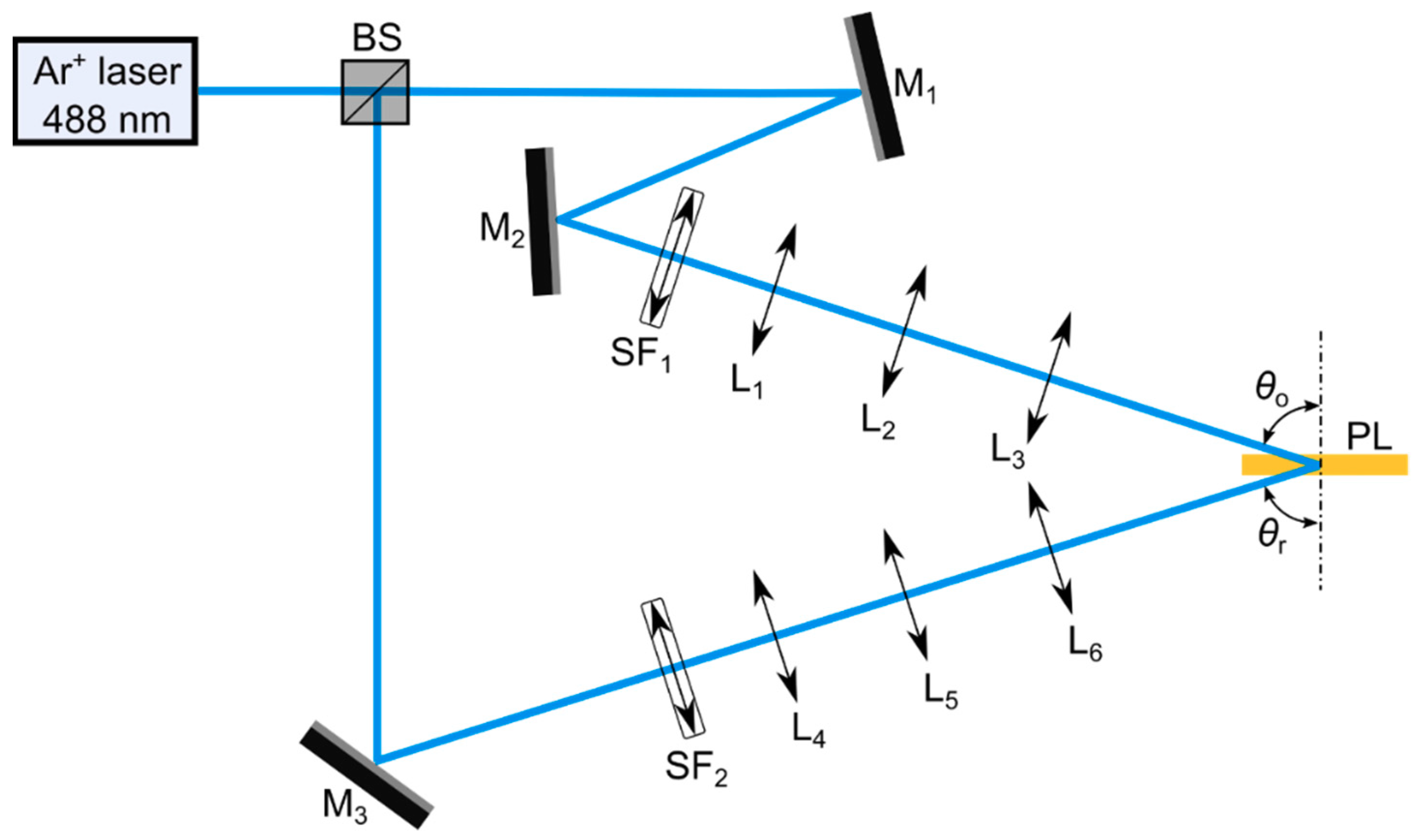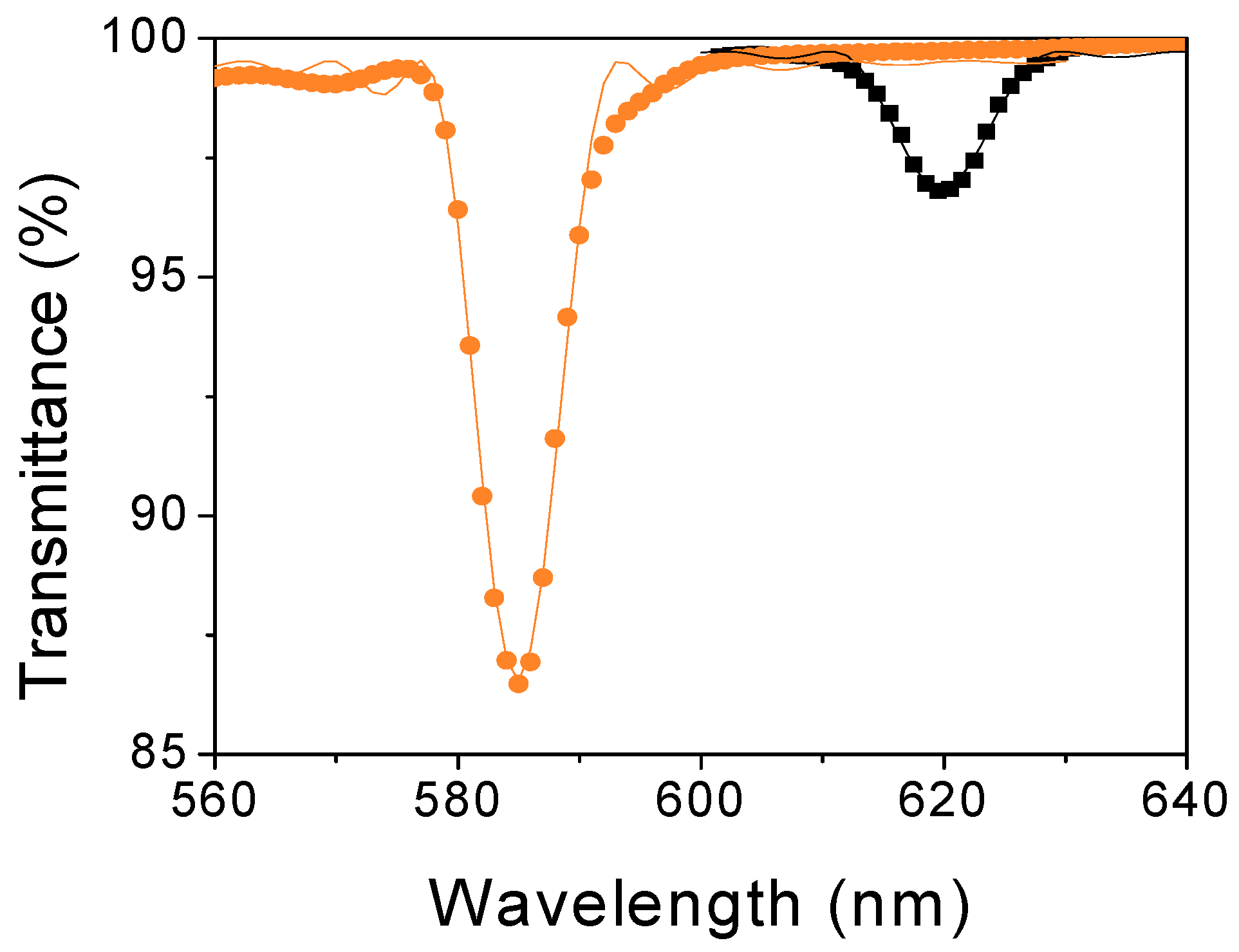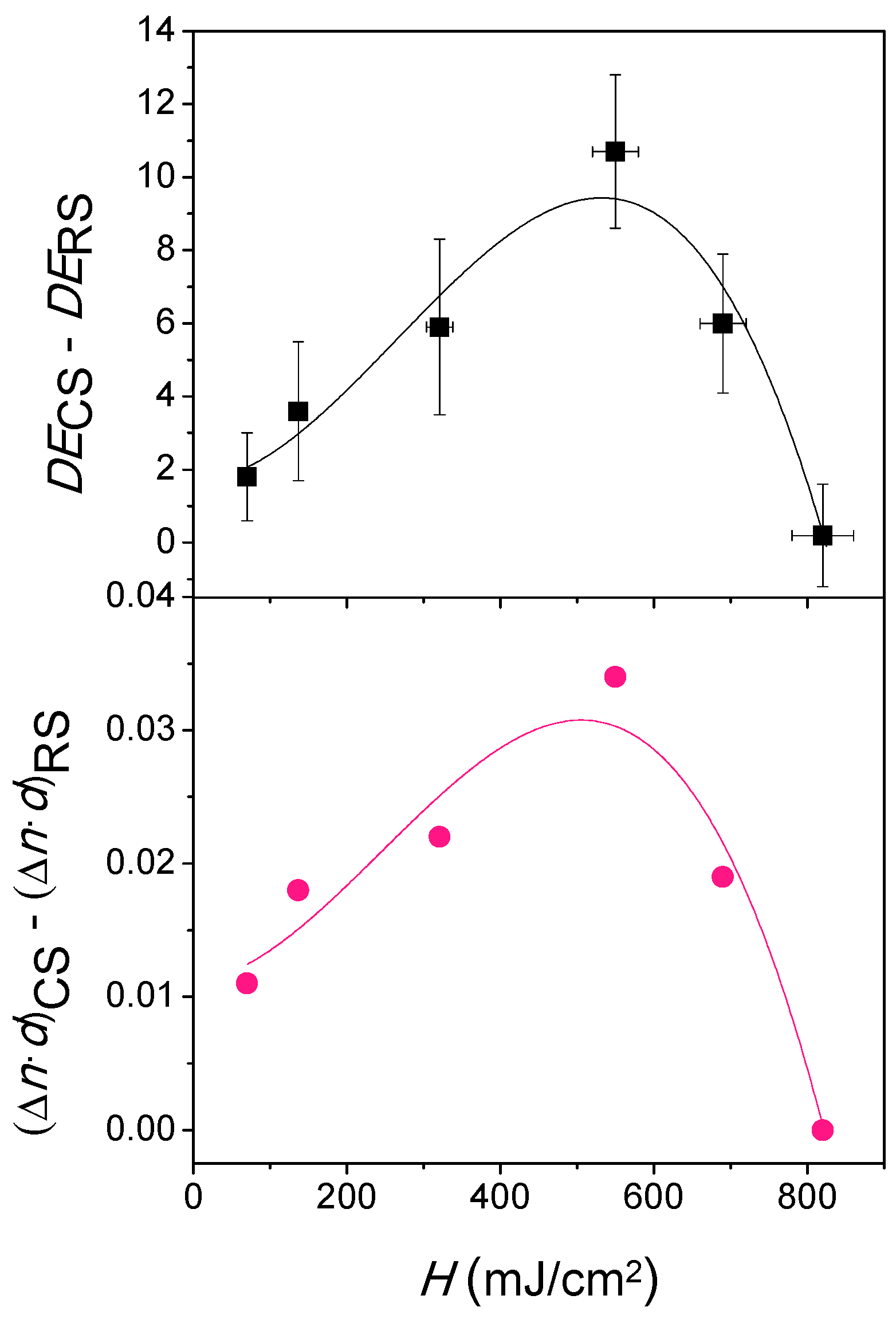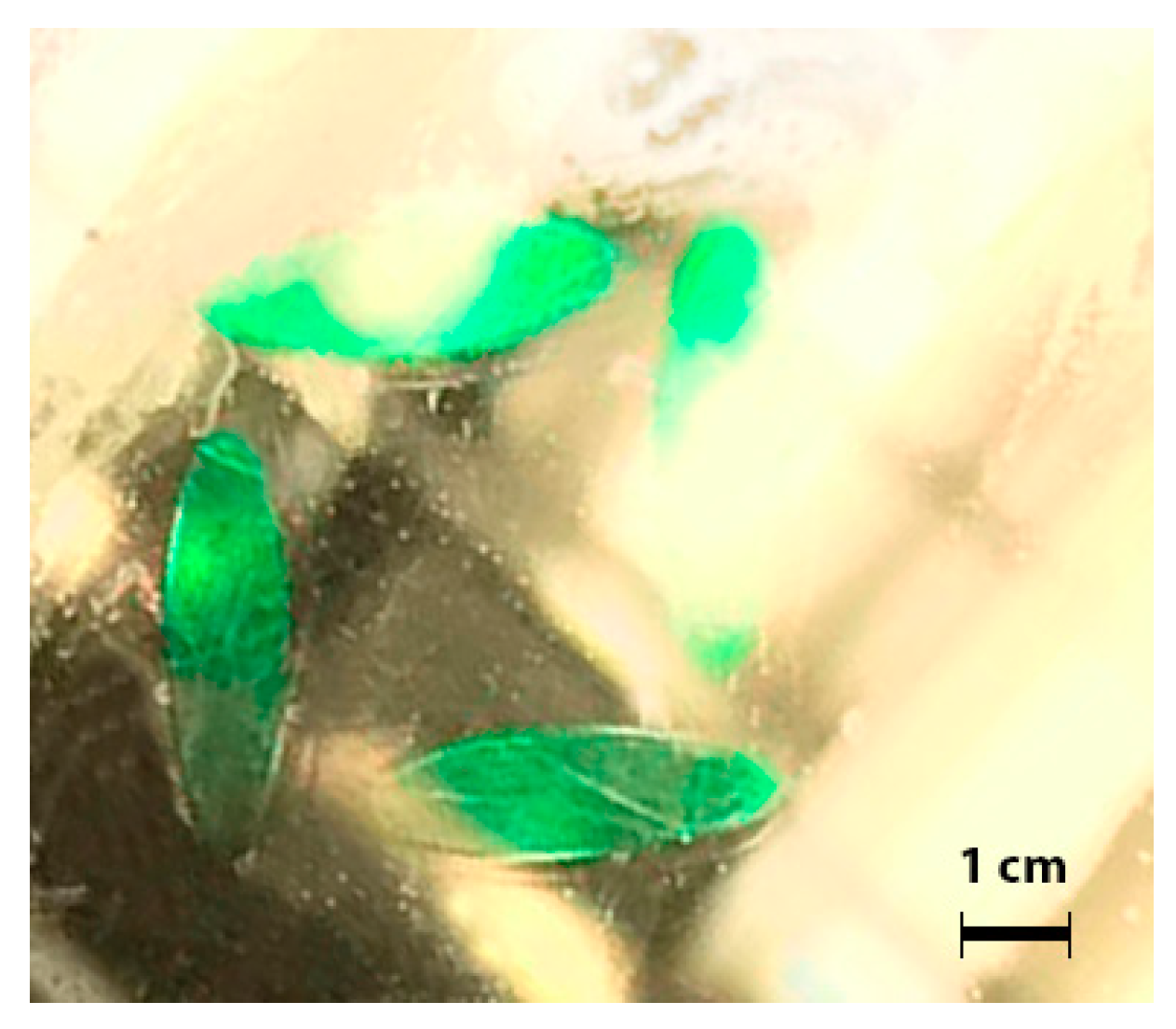LED-Cured Reflection Gratings Stored in an Acrylate-Based Photopolymer
Abstract
1. Introduction
2. Materials and Methods
2.1. Material Preparation
2.2. Holographic Reflection Setup
2.3. Analysis of Experimental Data Using Kogelnik’s Coupled Wave Theory
3. Results and Discussion
3.1. Optimization of the Preparation Conditions of Photopolymer Layers
3.2. Influence of Cured Time and Radiant Exposure on DE
3.3. Analysis of the Influence of Cured Time and Radiant Exposure on DE
4. Conclusions
Author Contributions
Acknowledgments
Conflicts of Interest
References
- Lu, H.; Li, R.P.; Sun, C.X.; Xiao, Y.; Tang, D.G.; Huang, M.J. Holographic property of photopolymers with different amine photoinitiators. Chin. Phys. B 2010, 19, 024212. [Google Scholar] [CrossRef]
- Defosse, Y.; Carré, C.; Lougnot, D.J. Use of a self-developing polymer material for volume reflection hologram recording. Pure Appl. Opt. J. Eur. Opt. Soc. Part A 1993, 2, 437–440. [Google Scholar] [CrossRef]
- Jallapuram, R.; Naydenova, I.; Martin, S.; Howard, R.; Toal, V.; Frohmann, S.; Orlic, S.; Eichler, H.J. Acrylamide-based photopolymer for microholographic data storage. Opt. Mater. 2006, 28, 1329–1333. [Google Scholar] [CrossRef]
- Bjelkhagen, H.I.; Mirlis, E. Color holography to produce highly realistic three-dimensional images. Appl. Opt. 2008, 47, A123–A133. [Google Scholar] [CrossRef] [PubMed]
- Fuentes, R.; Fernández, E.; García, C.; Beléndez, A.; Pascual, I. Study of reflection gratings recorded in polyvinyl alcohol/acrylamide-based photopolymer. Appl. Opt. 2009, 48, 6553–6557. [Google Scholar] [CrossRef]
- Yonetani, Y.; Nitta, K.; Matoba, O. Numerical evaluation of angular multiplexing in reflection-type holographic data storage in photopolymer with shrinkage. Appl. Opt. 2010, 49, 694–700. [Google Scholar] [CrossRef]
- Yetisen, A.K.; Montelongo, Y.; Qasim, M.M.; Butt, H.; Wilkinson, T.D.; Monteiro, M.J.; Yun, S.H. Photonic nanosensor for colorimetric detection of metal ions. Anal. Chem. 2015, 87, 5101–5108. [Google Scholar] [CrossRef] [PubMed]
- Liu, H.; Wang, R.; Yu, D.; Luo, S.; Li, L.; Wang, W.; Song, Q. Direct light written holographic volume grating as a novel optical platform for sensing characterization of solution. Opt. Laser Technol. 2019, 109, 510–517. [Google Scholar] [CrossRef]
- Liu, H.; Yu, D.; Zhou, K.; Wang, S.; Luo, S.; Li, L.; Wang, W.; Song, Q. Novel pH-sensitive photopolymer hydrogel and its holographic sensing response for solution characterization. Opt. Laser Technol. 2018, 101, 257–267. [Google Scholar] [CrossRef]
- Mikulchyk, T.; Martin, S.; Naydenova, I. N-isopropylacrylamide-based photopolymer for holographic recording of thermosensitive transmission and reflection gratings. Appl. Opt. 2017, 56, 6348–6356. [Google Scholar] [CrossRef]
- Kubota, T.; Ose, T. Lippmann color holograms recorded in methylene-blue sensitized dichromated gelatin. Opt. Lett. 1979, 1, 289–291. [Google Scholar] [CrossRef]
- Oliva, J.; Boj, P.G.; Pardo, M. Dichromated gelatin holograms derivated from agfa 8E75 HD plates. Appl. Opt. 1984, 23, 196–197. [Google Scholar] [CrossRef] [PubMed]
- Kim, J.M.; Choi, B.S.; Kim, J.M.; Bjelkhagen, H.I.; Phillips, N.J. Holographic optical elements recorded in silver halide sensitized gelatin emulsions Part 2 Reflection holographic optical elements. Appl. Opt. 2002, 41, 1522. [Google Scholar] [CrossRef]
- Beléndez, A.; Neipp, C.; Flores, M.; Pascual, I. High-efficiency silver-halide sensitized gelatin holograms with low absorption and scatter. J. Mod. Opt. 1998, 45, 1985–1992. [Google Scholar] [CrossRef][Green Version]
- Close, D.H.; Jacobson, A.D.; Margerum, J.D.; Brault, R.G.; McClung, F.J. Hologram recording on photopolymer materials. Appl. Phys. Lett. 1969, 14, 159–160. [Google Scholar] [CrossRef]
- Gallego, S.; Ortuño, M.; Neipp, C.; Márquez, A.; Beléndez, A.; Pascual, I. Characterization of polyvinyl alcohol/acrylamide holographic memories with a first-harmonic diffusion model. Appl. Opt. 2005, 44, 6205–6210. [Google Scholar] [CrossRef]
- Kozna, A. Effects of film-grain noise in holography. J. Opt. Soc. Am. 1968, 58, 436–438. [Google Scholar] [CrossRef]
- Pascual, I.; Beléndez, A.; Mateos, F.; Fimia, A. Comparison between direct method and the copying method to obtain in HOEs in AZ-1350 photoresist material. Ópt. Pura Apl. 1991, 24, 63–67. [Google Scholar]
- Gunter, P.; Huignard, J.P. Photorefractive Materials and Their Applications 3; Buse, K., Havermeyer, F., Liu, W., Moser, C., Psaltis, D., Eds.; Springer: New York, NY, USA, 2007; pp. 295–317. [Google Scholar]
- Mihaylova, E.; Naydenova, I.; Martin, S.; Toal, V. Electronic speckle pattern shearing interferometer with a photopolymer holographic grating. Appl. Opt. 2004, 43, 2439–2442. [Google Scholar] [CrossRef]
- Lloret, T.; Navarro-Fuster, V.; Ramírez, M.G.; Ortuño, M.; Neipp, C.; Beléndez, A.; Pascual, I. Holographic lenses in an environment-friendly photopolymer. Polymers 2018, 10, 302. [Google Scholar] [CrossRef]
- Yetisen, A.K.; Naydenova, I.; Da Cruz Vasconcellos, F.; Blyth, J.; Lowe, C.R. Holographic sensors: Three-dimensional analyte-sensitive nanostructures and their applications. Chem. Rev. 2014, 114, 10654–10696. [Google Scholar] [CrossRef] [PubMed]
- Fouassier, J.P.; Allonas, X.; Burget, D. Photopolymerization reactions under visible lights: Principle, mechanisms and examples of applications. Prog. Org. Coat. 2003, 47, 16–36. [Google Scholar] [CrossRef]
- Marín-Sáez, J.; Atencia, J.; Chemisana, D.; Collados, M.-V. Characterization of volume holographic optical elements recorded in Bayfol HX photopolymer for solar photovoltaic applications. Opt. Express 2016, 24, A720. [Google Scholar] [CrossRef]
- Bañares-Palacios, P.; Álvarez-Álvarez, S.; Marín-Sáez, J.; Collados, M.-V.; Chemisana, D.; Atencia, J. Broadband behavior of transmission volume holographic optical elements for solar concentration. Opt. Express 2015, 23, A671–A681. [Google Scholar] [CrossRef]
- Fernández, E.; Ortuño, M.; Gallego, S.; Márquez, A.; García, C.; Beléndez, A.; Pascual, I. Multiplexed holographic data page storage on a polyvinyl alcohol/acrylamide photopolymer memory. Appl. Opt. 2008, 47, 4448–4456. [Google Scholar] [CrossRef]
- Malallah, R.; Li, H.; Kelly, D.P.; Healy, J.J.; Sheridan, J.T. A review of hologram storage and self-written waveguides formation in photopolymer media. Polymers. 2017, 9, 337. [Google Scholar] [CrossRef]
- Fernández, R.; Bleda, S.; Gallego, S.; Neipp, C.; Márquez, A.; Tomita, Y.; Pascual, I.; Beléndez, A. Holographic waveguides in photopolymers. Opt. Express 2019, 27, 827–840. [Google Scholar] [CrossRef]
- Gallego, S.; Márquez, A.; Méndez, D.; Neipp, C.; Ortuño, M.; Beléndez, A.; Fernández, E.; Pascual, I. Direct analysis of monomer diffusion times in polyvinyl/acrylamide materials. Appl. Phys. Lett. 2008, 92, 073306. [Google Scholar] [CrossRef]
- Weiss, V.; Millul, E.; Friesem, A.A. Photopolymeric holographic recording media: In-situ and real-time characterization. In Proceedings of the Photonic West, San Jose, CA, USA, 27 January–2 February 1996; Volume 2688, pp. 11–21. [Google Scholar]
- Ortuño, M.; Gallego, S.; García, C.; Pascual, I.; Neipp, C.; Beléndez, A. Holographic characteristics of an acrylamide/bisacrylamide photopolymer in 40–1000 µm thick layers. Phys. Scr. 2005, 2005, T118. [Google Scholar] [CrossRef]
- Gambogi, W.J.; Smothers, W.K.; Steijn, K.W.; Stevenson, S.H.; Weber, A.M. Color holography using DuPont holographic recording films. In Proceedings of the Photonic West, San Jose, CA, USA, 1–28 February 1995; Volume 2405. [Google Scholar]
- Berneth, H.; Bruder, F.K.; Fäcke, T.; Hagen, R.; Hönel, D.; Jurbergs, D.; Rölle, T.; Weiser, M. Holographic recording aspects of high resolution Bayfol HX photopolymer. In Proceedings of the SPIE OPTO, San Francisco, CA, USA, 22–27 January 2011; p. 79570. [Google Scholar]
- Ortuño, M.; Gallego, S.; Márquez, A.; Neipp, C.; Pascual, I.; Beléndez, A. Biophotopol: A sustainable photopolymer for holographic data storage applications. Materials 2012, 5, 772–783. [Google Scholar] [CrossRef]
- Navarro-Fuster, V.; Ortuño, M.; Fernández, R.; Gallego, S.; Marquez, A.; Beléndez, A.; Pascual, I. Peristrophic multiplexed holograms recorded in a low toxicity photopolymer. Opt. Mater. Express 2017, 7, 133–147. [Google Scholar] [CrossRef]
- Navarro-Fuster, V.; Ortuño, M.; Gallego, S.; Márquez, A.; Beléndez, A.; Pascual, I. Biophotopol’s energetic sensitivity improved in 300 μm layers by tuning the recording wavelength. Opt. Mater. 2016, 52, 111–115. [Google Scholar] [CrossRef]
- Ortuño, M.; Fernández, E.; Gallego, S.; Beléndez, A.; Pascual, I. New photopolymer holographic recording material with sustainable design. Opt. Express 2007, 15, 12425–12435. [Google Scholar] [CrossRef]
- Cody, D.; Gribbin, S.; Mihaylova, E.; Naydenova, I. Low-toxicity photopolymer for reflection holography. ACS Appl. Mater. Interfaces 2016, 8, 18481–18487. [Google Scholar] [CrossRef]
- Fernandez, E.; Fuentes, R.; Belendez, A.; Pascual, I. Influence of 4,4′-azobis (4-cyanopentanoic acid) in transmission and reflection gratings stored in a PVA/AA photopolymer. Materials 2016, 9, 194. [Google Scholar] [CrossRef]
- Cody, D.; Naydenova, I.; Mihaylova, E. Effect of glycerol on a diacetone acrylamide-based holographic photopolymer material. Appl. Opt. 2013, 52, 489–494. [Google Scholar] [CrossRef]
- Bertolotti, S.G.; Previtali, C.M.; Rufs, A.M.; Encinas, M.V. Riboflavin/triethanolamine as photoinitiator system of vinyl polymerization. A mechanistic study by laser flash photolysis. Macromolecules 1999, 32, 2920–2924. [Google Scholar] [CrossRef]
- Kogelnik, H. Coupled wave theory for thick hologram gratings. Bell Syst. Tech. J. 1969, 48, 2909–2947. [Google Scholar] [CrossRef]
- Jenney, J.A. Holographic recording with photopolymers. J. Opt. Soc. Am. 1970, 60, 1155–1161. [Google Scholar] [CrossRef]
- Tipton, M.D.; Armstrong, S.S. Improved process of refrection holography replication and heat processing. Procceding of the IS&T/SPIE 1994 International Symposium on Electronic Imaging: Science and Technology, San Jose, CA, USA, 6–10 February 1994; Volume 2176, pp. 172–183. [Google Scholar]
- Cody, D.; Naydenova, I.; Mihaylova, E. New non-toxic holographic photopolymer material. J. Opt. 2012, 14, 015601. [Google Scholar] [CrossRef]
- Naydenova, I.; Jallapuram, R.; Howard, R.; Martin, S.; Toal, V. Investigation of the diffusion processes in a self-processing acrylamide-based photopolymer system. Appl. Opt. 2004, 43, 2900–2905. [Google Scholar] [CrossRef]
- Cody, D.; Mihaylova, E.; O’Neill, L.; Naydenova, I. Determination of the polymerisation rate of a low-toxicity diacetone acrylamide-based holographic photopolymer using Raman spectroscopy. Opt. Mater. 2015, 48, 12–17. [Google Scholar] [CrossRef][Green Version]
- Ren, X.; Yang, Z.; Kuang, T. Solvent-induced changes in photochemical activity and conformation of photosystem I particles by glycerol. Biol. Chem. 2006, 387, 23–29. [Google Scholar] [CrossRef]
- Tomita, Y.; Urano, H.; Fukamizu, T.; Kametani, Y.; Nshimura, N.; Doi, K.E.O. Nanoparticle-polymer composite volume holographic gratings dispersed with ultrahigh-refractive-index hyperbranched polymer as organic nanoparticles. Opt. Lett. 2016, 41, 1281–1284. [Google Scholar] [CrossRef]
- Ishizu, K.; Ochi, K.; Tomita, Y.; Furushima, K.; Odoi, K. A new class of holographic recording constructed by hyperbranched polymers dispersed in photopolymer film. Des. Monomers Polym. 2006, 9, 403–411. [Google Scholar] [CrossRef]







| H (mJ/cm2) | Cured | Δn | d (µm) | Δn·d (µm) | Λ (µm) | DEmax (%) |
|---|---|---|---|---|---|---|
| 70 | No (RS *) | 0.0012 | 16.0 | 0.019 | 0.207 | 0.9 |
| Yes (CS ¤) | 0.0035 | 8.6 | 0.030 | 0.194 | 2.7 | |
| 137 | No (RS) | 0.0017 | 16.4 | 0.028 | 0.204 | 1.9 |
| Yes (CS) | 0.0044 | 10.2 | 0.046 | 0.197 | 5.5 | |
| 321 | No (RS) | 0.0018 | 20.7 | 0.037 | 0.207 | 3.6 |
| Yes (CS) | 0.0036 | 16.5 | 0.059 | 0.198 | 9.5 | |
| 550 | No (RS) | 0.0025 | 14.4 | 0.036 | 0.206 | 3.4 |
| Yes (CS) | 0.0050 | 13.9 | 0.070 | 0.196 | 14.1 | |
| 690 | No (RS) | 0.0030 | 10.7 | 0.032 | 0.203 | 2.6 |
| Yes (CS) | 0.0050 | 10.3 | 0.051 | 0.191 | 8.6 | |
| 820 | No (RS) | 0.0027 | 10.6 | 0.029 | 0.201 | 2.4 |
| Yes (CS) | 0.0030 | 9.6 | 0.029 | 0.192 | 2.6 |
© 2019 by the authors. Licensee MDPI, Basel, Switzerland. This article is an open access article distributed under the terms and conditions of the Creative Commons Attribution (CC BY) license (http://creativecommons.org/licenses/by/4.0/).
Share and Cite
Ramírez, M.G.; Sirvent, D.; Morales-Vidal, M.; Ortuño, M.; Martínez-Guardiola, F.J.; Francés, J.; Pascual, I. LED-Cured Reflection Gratings Stored in an Acrylate-Based Photopolymer. Polymers 2019, 11, 632. https://doi.org/10.3390/polym11040632
Ramírez MG, Sirvent D, Morales-Vidal M, Ortuño M, Martínez-Guardiola FJ, Francés J, Pascual I. LED-Cured Reflection Gratings Stored in an Acrylate-Based Photopolymer. Polymers. 2019; 11(4):632. https://doi.org/10.3390/polym11040632
Chicago/Turabian StyleRamírez, Manuel G., Daniel Sirvent, Marta Morales-Vidal, Manuel Ortuño, Francisco J. Martínez-Guardiola, Jorge Francés, and Inmaculada Pascual. 2019. "LED-Cured Reflection Gratings Stored in an Acrylate-Based Photopolymer" Polymers 11, no. 4: 632. https://doi.org/10.3390/polym11040632
APA StyleRamírez, M. G., Sirvent, D., Morales-Vidal, M., Ortuño, M., Martínez-Guardiola, F. J., Francés, J., & Pascual, I. (2019). LED-Cured Reflection Gratings Stored in an Acrylate-Based Photopolymer. Polymers, 11(4), 632. https://doi.org/10.3390/polym11040632









